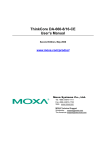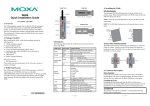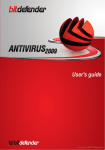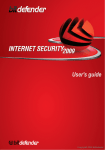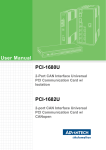Download W406-CE User`s Manual v1
Transcript
W406 WinCE
User’s Manual
First Edition, April 2009
www.moxa.com/product
© 2009 Moxa Inc. All rights reserved.
Reproduction without permission is prohibited.
W406 WinCE User’s Manual
The software described in this manual is furnished under a license agreement and may be used only in
accordance with the terms of that agreement.
Copyright Notice
Copyright © 2009 Moxa Inc.
All rights reserved.
Reproduction without permission is prohibited.
Trademarks
MOXA is a registered trademark of Moxa Inc.
All other trademarks or registered marks in this manual belong to their respective manufacturers.
Disclaimer
Information in this document is subject to change without notice and does not represent a commitment on the
part of Moxa.
Moxa provides this document “as is,” without warranty of any kind, either expressed or implied, including, but
not limited to, its particular purpose. Moxa reserves the right to make improvements and/or changes to this
manual, or to the products and/or the programs described in this manual, at any time.
Information provided in this manual is intended to be accurate and reliable. However, Moxa assumes no
responsibility for its use, or for any infringements on the rights of third parties that may result from its use.
This product might include unintentional technical or typographical errors. Changes are made periodically to the
information in this manual to correct such errors, and these changes are incorporated into new editions of the
publication.
Technical Support Contact Information
www.moxa.com/support
Moxa Americas:
Toll-free: 1-888-669-2872
Tel: +1-714-528-6777
Fax: +1-714-528-6778
Moxa China (Shanghai office):
Toll-free: 800-820-5036
Tel: +86-21-5258-9955
Fax: +86-10-6872-3958
Moxa Europe:
Tel: +49-89-3 70 03 99-0
Fax: +49-89-3 70 03 99-99
Moxa Asia-Pacific:
Tel: +886-2-8919-1230
Fax: +886-2-8919-1231
Table of Contents
Chapter 1
Introduction ..................................................................................................1-1
Overview.................................................................................................................................. 1-2
W406 Software ........................................................................................................................ 1-2
Applications Development Environment...................................................................... 1-2
Networking and Communications Capabilities ............................................................ 1-3
Supported Servers and Daemons .................................................................................. 1-3
Obtaining the Firmware Build Version .................................................................................... 1-4
Memory and File Systems ....................................................................................................... 1-4
RAM File System ......................................................................................................... 1-4
Flash File System.......................................................................................................... 1-4
External File System..................................................................................................... 1-4
Cautions when Using File Systems .............................................................................. 1-4
Using a RAM File System instead of a Flash File System ........................................... 1-5
Hive-based Registry................................................................................................................. 1-5
Connect to Network via Ethernet............................................................................................. 1-5
Cellular Networking ................................................................................................................ 1-5
Inserting an SD Card into the Computer.................................................................................. 1-6
Connecting a USB Mass Storage Device to the Computer ...................................................... 1-6
Serial Ports............................................................................................................................... 1-6
Console Port ................................................................................................................. 1-6
RS-232/422/485 Serial Ports ........................................................................................ 1-6
Chapter 2
Getting Started .............................................................................................2-1
Starting Your W406 Computer................................................................................................. 2-2
Resetting Your W406 Computer .............................................................................................. 2-2
Boot Loader ............................................................................................................................. 2-3
Operating Your W406 Computer through the Serial Console.................................................. 2-3
Changing the Network Settings ............................................................................................... 2-4
Connecting to a GPRS/EDGE Network................................................................................... 2-4
Disconnecting from a GPRS/EDGE Network ......................................................................... 2-6
GPRS/EDGE Connection Error Detection............................................................................... 2-7
SIM Card Lock Utilities........................................................................................................... 2-7
Sending and Receiving SMS Messages ................................................................................... 2-8
Sending AT Command ........................................................................................................... 2-10
Operating Your W406 Computer through a Telnet Client.......................................................2-11
User/Group Management........................................................................................................2-11
System Time Management..................................................................................................... 2-12
Adjusting OS Time Zone ....................................................................................................... 2-12
SNTP Client ........................................................................................................................... 2-12
Starting and Stopping Services .............................................................................................. 2-13
Troubleshooting Network Connectivity................................................................................. 2-13
Simple Network Management Protocol (SNMP)................................................................... 2-14
Chapter 3
Web-based Management System ...............................................................3-1
Logging onto the Web-based Management System ................................................................. 3-2
System Information.................................................................................................................. 3-2
Networking/Server Configuration............................................................................................ 3-3
Serial Port Configuration ......................................................................................................... 3-3
Monitoring and Controlling Processes (Threads) .................................................................... 3-4
Launching Processes Automatically ........................................................................................ 3-4
Monitoring and Controlling Services....................................................................................... 3-5
Binary/Text File Management ................................................................................................. 3-5
Appendix A Firmware Upgrade Procedure.................................................................... A-1
Appendix B Application Development ........................................................................... B-1
Developing an application with VS2005 .................................................................................B-1
Visual C++ Examples ..............................................................................................................B-2
Visual C# Examples...............................................................................................................B-19
1
Chapter 1
Introduction
The W406 embedded computer has two RS-232/422/485 serial ports, one 10/100 Mbps Ethernet
port, an embedded GSM/GPRS/EDGE module, an SD socket interface for storage expansion, one
USB 2.0 host port, four digital input channels, and four digital output channels. This combination
of features makes the W406 ideal for your wireless embedded applications.
The RISC-based W406 embedded computers come with the Windows® CE operating system
pre-installed. Microsoft® Windows® CE 6.0 is an open, scalable, 32-bit operating system that
allows users to build a wide range of innovative, small footprint devices. A typical Windows®
CE-based device is designed for a specific use, and often runs disconnected from other computers,
or distributed as a front-end to a centralized host. Examples include enterprise tools, such as
industrial controllers, communications hubs, point-of-sale terminals, and display devices, such as
HMI, advertisement appliances, and interactive panels.
The following topics are covered in this chapter:
Overview
W406 Software
¾ Applications Development Environment
¾ Networking and Communications Capabilities
¾ Supported Servers and Daemons
Obtaining the Firmware Build Version
Memory and File Systems
¾ RAM File System
¾ Flash File System
¾ External File System
¾ Cautions when Using File Systems
¾ Using a RAM File System instead of a Flash File System
Hive-based Registry
Connect to Network via Ethernet
Cellular Networking
Inserting an SD Card into the Computer
Connecting a USB Mass Storage Device to the Computer
Serial Ports
¾ Console Port
¾ RS-232/422/485 Serial Ports
W406-CE User’s Manual
Introduction
Overview
The W406 is an embedded Linux or WinCE computer that features 2 software selectable
RS-232/422/485 ports, 1 Ethernet port, and quad-band GSM/GPRS/EDGE 900/1800/850/1900
MHz for cellular communication. It also comes with an SD socket, USB host, and 4 digital input
and 4 digital output channels, making it the ideal computer for a variety of industrial applications
such as data acquisition, data processing, protocol conversion, and remote device control and
monitoring via wireless communication. The W406 comes pre-installed with either Linux or
WinCE 6.0, and offers a reliable and powerful computing platform for industrial environments.
Programmers will find that the W406 provides a convenient programming environment for
producing bug-free industrial applications at a lower cost.
W406 Software
The W406 embedded computer is a ready-to-run, RISC-based, “headless” computer with a robust
and network-centric design. It uses the Microsoft® Windows® CE 6.0 operating system.
Developers of embedded communication applications will find that the open programming
environment makes the W406 well-suited for both new system development and legacy system
migration.
Applications Development Environment
y
C Libraries and Run-times—Compared to the C libraries and run-times used on a desktop
PC running Windows®, the C libraries and run-times on a W406 WinCE are a subset of the
WIN32 APIs. The system supports a full ANSI C run-time, standard input/output library,
standard input/output ASCII library, and standard ASCII string functions. In addition, C++
compiler exception handling and Run-Time Type Information (RTTI) equivalent to desktop
C++ compilers are supported.
y
Active Template Library—Active Template Library (ATL) for Windows CE is a C++
template library designed to help create small, fast Microsoft® ActiveX® servers. An ActiveX
server is a dynamic-link library (DLL) or executable (.exe) that contains one or more
Component Object Model (COM) components. COM components can be anything from a
simple dialog box to a full ActiveX control.
y
Component Services (COM)—The Common Object Model (COM) is an operating
system-independent, object-oriented system for creating binary software components that can
interact with other COM-based components in the same process space, in other processes, or
on remote machines.
y
Microsoft® .NET Compact Framework 2.0 with service pack 2—It offers a choice of
languages, initially Microsoft® Visual Basic® and Microsoft® Visual C#, and eliminates the
common problems faced with language interoperability.
y
XML—support for XML Query Language (XQL)
y
Winsock 2.2—Provides enhanced capabilities over Winsock 1.1, including installable service
providers for additional third-party protocols, and Media sense.
1-2
W406-CE User’s Manual
Introduction
Networking and Communications Capabilities
y
y
y
y
y
Simple Network Management Protocol (SNMP)—Monitors remote connections to the
network.
Simple Network Time Protocol (SNTP) Client—Provides support for synchronizing the
device’s system time with an SNTP server, and supports Daylight Savings Time.
Serial Communications—In addition to the 16550 UART driver bound to a debug port and
the console port, a special driver for 2 additional Moxa serial ports is also included.
Network Utilities (IpConfig, Ping, Route)—Utilities for troubleshooting various network
problems.
TCP/IP—Includes IP, Address Resolution Protocol (ARP), Internet Control Message Protocol
(ICMP), Internet Group Membership Protocol (IGMP), Transmission Control Protocol (TCP),
User Datagram Protocol (UDP), name resolution and registration, and DHCP.
Supported Servers and Daemons
y
Telnet Server—A sample server that allows remote administration through a standard Telnet
client.
y
FTP Server—A sample server used for transferring files to and from remote computer
systems over a network using TCP/IP.
y
File Server—The File Server functionality in Microsoft® Windows® CE enables clients to
access files and other resources over the network.
y
Dial-up Networking—Consists of RAS client API and the Point to Point Protocol (PPP).
RAS and PPP support Extensible Authentication Protocol (EAP) and RAS scripting.
y
Watchdog—A CPU Hardware function for reset CPU in a user specified time interval. You
must call the MOXA library function to trigger it.
y
Web Server (HTTPD)—Includes ASP, ISAPI Secure Socket Layer support, SSL 2, SSL 3,
Transport Layer Security (TLS/SSL 3.1) public key-based protocols, and Web Administration
ISAPI Extensions.
1-3
W406-CE User’s Manual
Introduction
Obtaining the Firmware Build Version
There are two ways to obtain the firmware version of W406 embedded computers. This
information is particularly important for identifying the features supported by the computer.
y
Examine the welcome message after you log on to the computer.
y
Log on to the web-based management system (described in a later chapter) to view the system
information.
Memory and File Systems
The 32 MB of SDRAM is divided into two main parts. The main memory, which houses the
operating system and user applications, has a capacity of about 20 MB. The kernel image occupies
the remainder of the memory space.
RAM File System
The internal file system in the W406 computer controls access to flash and also provides file
storage in the object store, which is in the RAM. The root directory is a RAM file system of size 4
MB. Child directories such as “Windows,” “Temp,” “My Documents,” “Network,” and “Program
Files” are under the root directory. They can be used for storing temporary files for your
applications. However, do not place persistent files or applications in these directories because
they will be deleted when the system is shut down. Instead, place them in the “NORFlash”
directory.
Flash File System
The Flash file system provides persistent storage for applications and related data, even when the
main power supply is lost. The system integrates the read-only files that are stored on the Flash
with the read/write files from both applications and users. A child directory named “NORFlash” is
created under the root; the size of the directory is 3 MB.
External File System
The additional file systems from USB and SD storage devices are placed in the root of the internal
file system. If you intend to use these devices to port data between your PC and the W406
computer, you should format them using the FAT file system on your PC.
Cautions when Using File Systems
We recommend storing your programs only in the on-board NOR Flash. Please store the log data
generated by your programs in an external storage device such as an SD card or Network File
System. Note that a Network File System will generally provide more storage space than the SD
card. In addition, it is easier to replace a full or damaged Compact Flash than an on-board NOR
Flash.
A NOR Flash has a life cycle of 100,000 write operations in block (128 KB) level, and does not
support BBM (Bad Block Management). For this reason, the FAT file system would not know
when a flash block has reached its cycle, and would try to scan the block repeatedly.
FAT sequentially searches for free memory space for write operations. After deleting many files,
the memory space could become fragmented, making it more difficult to search for free space. If
your program updates (deletes and then creates) a file frequently, it is quite possible that the
program writes data to the same flash area. In the long run, FAT would be blocked when scanning
the area and would cause the operating system to hang.
1-4
W406-CE User’s Manual
Introduction
An SD card has its own life cycle. Since most SD cards are made from a NAND Flash, their
hardware controllers implement BBM. This feature allows FAT to skip bad blocks if they exist.
Furthermore, the memory space of an SD card is much larger than that of the NOR Flash. Using
this space cautiously will ensure that its life cycle is not exceeded. When creating a file for storing
log data, we suggest creating a large empty file (e.g., 30 MB), and then writing data evenly to that
space. When the space is used up, the program rewinds the write operations. As a result, the
number of write operations to each block is reduced.
Using a RAM File System instead of a Flash File System
Even though data in the RAM file system will be deleted after shutting off the power, using the
RAM file system has several advantages over using the Flash file system, including faster
read/write access and not needing to deal with the life cycle issue.
For important applications that relay data back to the host directly, you should write the necessary
log data to the RAM file system. After the host accesses the data, the application erase the data,
freeing up the memory space for further use.
The embedded computer has limited resources, and designers should decide if storing data in a file
system is really necessary. If it is necessary, be sure to choose the most appropriate file system.
Hive-based Registry
The registry for the W406 is a hive-based registry instead of a RAM-based registry. The
hive-based registry stores registry data inside files, or hives, which can be stored in any file system.
This eliminates the need for performing backup and restoring power.
The registry data will be automatically flushed by default. If AutoFlush is disabled, the
RegFlushKey function is needed when you change the registry value in your applications. The
RegAutoFlush.exe utility is provided for users to change the auto-flush setting.
The RegAutoFlush.exe utility can be found at the utility_tools directory on CD
Type RegAutoFlush -d to disable auto-flush setting.
\> RegAutoFlush -d
OR type RegAutoFlush -e to enable auto-flush setting.
\> RegAutoFlush –e
Connect to Network via Ethernet
The W406 computer offers a 10/100M RJ-45 Ethernet port for network redundancy.
Cellular Networking
The W406 computer has been embedded with a GSM/GPRS/EDGE cellular module for a reliable
and stable wireless communication. It supports quad-band GSM/GPRS/EDGE 850/900/1800/1900
MHz, and GPRS/EDGE Class 10. Meanwhile, it offers SMS tunnel mode for auto configuration
and SIM card authentication.
1-5
W406-CE User’s Manual
Introduction
Inserting an SD Card into the Computer
The W406 is equipped with an SD slot. When an empty SD card is inserted into the slot, the
computer automatically formats it to the FAT system. This process takes a few minutes to
complete. After an SD card is inserted, the embedded computer will create a directory named
“StorageDisk” under the root directory. The “StorageDisk” directory controls access to the SD
storage space. The embedded computer will create a directory called “StorageDisk2” if another
USB storage device is plugged in at a later time.
Connecting a USB Mass Storage Device to the Computer
The USB mass storage device is considered to be highly portable between your PC and a computer
that does not support the TFAT system. We suggest that you format your devices with the FAT
format. When the first USB storage device is plugged into the slot on the back of the computer, a
directory named “USBDisk” under the root directory is created in the internal file system as a link
to the storage device. The embedded computer will create a directory called “StorageDisk2” if
another SD storage device is plugged in at a later time.
The following table lists USB mass storage devices that have been tested successfully for
compatibility.
Vendor
CRUZER
Intel
Abocom
PQI
Transcend
Transcend
Device Name
mini
Flash memory
Size
128 MB
128 MB
128 MB
256 MB
512 MB
1 GB
JetFlash
JetFlash
ATTENTION
Some USB storage devices may not be detected by the system. We suggest that you use one of
the devices listed in the above table, since these USB mass storage devices have been tested
successfully for compatibility.
Serial Ports
Console Port
The serial console port, located on the bottom panel is a 4-pin pin-header RS-232 port. It is
designed for serial console terminals, which are useful for viewing boot-up messages, system
configuration and develop applications.
RS-232/422/485 Serial Ports
The W406 computer contains two software-selectable RS-232/422/485 ports for reliable and stable
serial communication. They support non-standard baudrates settings up to 921,600 bps.
1-6
2
Chapter 2
Getting Started
In this chapter, we explain how to use a PC to operate a W406 embedded computer. We will refer
to the PC that connects to the W406 as a development workstation, and the W406 embedded
computer will be called a target computer.
development workstation =
target computer
=
PC used to operate the embedded computer
W406 embedded computer
In addition, we describe the steps you should follow to carry out certain operations, such as setting
the system time and troubleshooting network connectivity. Some of these operations can be carried
out using system commands after gaining access to the target computer, and others can be carried
out using a web-based management system. The web-based management system is described in a
later chapter.
The following topics are covered in this chapter:
Starting Your W406 Computer
Resetting Your W406 Computer
Operating Your W406 Computer through the Serial Console
Changing the Network Settings
Operating Your W406 Computer through a Telnet Client
User/Group Management
System Time Management
Starting and Stopping Services
Troubleshooting Network Connectivity
Simple Network Management Protocol (SNMP)
W406-CE User’s Manual
Getting Started
Starting Your W406 Computer
Connect the SG wire to the shielded contact located in the upper left corner of the W406 computer,
and then power it up by connecting it to the power adaptor. It takes about 30 to 60 seconds for the
system to boot up. Once the system is ready, the “Ready” LED will light up. The light will stay lit
until you shut down the computer.
Resetting Your W406 Computer
When the target computer stops responding, or an application locks up, or the target computer fails
to work normally, you may need to restart or reset the target computer’s operating system. We
provide four ways to restart or reset the operating system.
Warm-Start: When the computer is powered on, insert a pin into the “Reset” hole next to the
serial console, and hold for 1 to 2 seconds. The computer will reboot automatically.
Cold-Start: Unplug the power line and then plug it back in again. The computer will reboot
automatically.
Resetting to Factory Defaults: If the computer is not working properly, and you want to reset it
back to factory default settings, press and hold the “Reset” button for at least 5 seconds. The
buzzer will sound while the factory default settings are being loaded. After the factory defaults
have been loaded, the computer will reboot automatically.
Resetting the System: In rare circumstances, the FAT file system may be damaged by executing
improper applications, or due to an unstable power supply. In this case, the computer may fail to
boot up if the FAT table crashes. In order to get the system back up and running, you will need to
format the flash disk and reset the operating system. Note that all user files and configurations will
be erased. The following steps show how to format the flash disk through boot loader utilities.
Step 1: Power off the W406 embedded computer.
Step 2: Connect the W406 to your PC using the console port cable.
Step 3: Start a terminal program with the settings: Baudrate = 115200, no hardware flow control,
8 N 1, character set VT100.
Step 4: Hold in the “DEL” key on your PC.
Step 5: Power on the W406. You will be guided to boot loader utility menu.
2-2
W406-CE User’s Manual
Getting Started
Step 6: Type “2” for “Format User Disk”, and then press Enter.
Step 7: After a few seconds, you will see the bootloader menu again. Unplug the power line and
then plug it back again. It takes about 3 minutes to reset the operating system.
Boot Loader
For the OS stability issue, we provide an easy and useful function with Boot Loader for the
following tasks:
1. Reset to default: you can set the flag to reset WinCE 6.0 to factory default settings.
2. Format storage flash: The CE 6.0 file system is an FAT that can be damaged by unstable
power or improper application execution. If the FAT table crashes, do not start up the OS. You
can, however, format the file system and reboot your W406.
At startup, the W406 will check the file system and re-partition it if the file system is empty.
3. Firmware upgrade: If you find a new firmware from Moxa’s website, you can upgrade the
firmware with this function (details in appendix A).
Go to the boot loader menu from serial console:
Step 1: Power off your W406 device.
Step 2: Make sure the serial console wire is connected to your PC correctly.
Step 3: Go to [Start] Æ [Programs] Æ [Accessories] Æ [Communication] Æ [Terminal] to
create a new terminal communication with the following settings: baudrate of 115200,
no hardware flow control, 8 N 1, and character set VT100.
Step 4: Activate this terminal window on your PC.
Step 5: Hold “DEL” key continuously.
Step 6: Power on the W406 device.
Operating Your W406 Computer through the Serial Console
The serial console port (located on the bottom panel) gives users a convenient way of connecting
the development workstation to the console utility of the target computer. This method is
particularly useful when using the computer for the first time.
After you have wired a serial cable, go back to the development workstation and start a terminal
program (e.g., HyperTerminal) by using the settings shown below for the serial console port.
Baudrate
Parity
Data bits
Stop bits
Flow Control
Terminal
115200 bps
None
8
1
None
ANSI
After a successful connection, type the login name and password as requested to log on to the
computer. The default values are both admin.
Login: admin
Password: admin
2-3
W406-CE User’s Manual
Getting Started
Changing the Network Settings
The W406 computer has one network interface. There is no default IP address; the default network
setting is configured as DHCP. If you have a DHCP server, simply connect the W406 to your
network using an Ethernet cable. An IP address will automatically be appointed to the W406. If
you would like to use a fixed IP address, you should use netconfig command.
The netconfig command is a utility that is used to complete the task. Before changing the IP
addresses, type netconfig -h to list the help for this command.
\> netconfig -h
Usage: netconfig -n <AdapterName | Alias> [-EnableDHCP] [-i <IP address>] [-m < etmask>]
[-g <gateway>] [-d <DNS server>] [-w <WINS Server>] [-noask] e.g.: netconfig -n
IXP425ETHNPE1 -i 192.168.10.101 -g 192.168.10.254: netconfig -n CS89501 -i
192.168.12.101 -m 255.255.0.0: netconfig -n PCIRTL81391 -EnableDHCP
Alias: LAN1=CS89501
For example, if your development workstation has a LAN port at 192.168.1.1, and the IP address
of the Domain Name Server (DNS) is 192.168.2.6, execute the following command.
\> netconfig –n LAN1 –i 192.168.1.5 –m 255.255.255.0 –g 192.168.1.254 –d 192.168.2.6
Use the netconfig command to view the updated settings.
\> netconfig
LAN1 Interface Configuration:
IP Address:
192.168.1.5
SubNet Mask:
255.255.255.0
Gateway:
192.168.1.254
DNS:
192.168.2.6
Connecting to a GPRS/EDGE Network
Before connecting to a GPRS/EDGE network, make sure the SIM card is properly installed and
the antenna is connected. (Please refer to W406 Hardware User’s Manual for installation details.)
Note that the SIM card must be installed when the embedded computer is powered off. The LED
indicators on the top panel can be used to check the signal strength.
The W406 provides two programs to help users connect to a network via cellular communication.
When the SIM card is inserted, GPRSAutodetect.exe will detect the configuration and create the
entry automatically if the -l parameter is entered. It will log the connection process into the
GPRSLog.txt file. After the entry has been created, you can use GPRSConnect.exe to connect to
the Internet via cellular module. The GPRSConnect.exe file also supports an automatic
reconnection function to retry the connection if the connection is not established.
NOTE: Do not execute the –d option when the reconnection function is activated and the
connection has not been established, or else the reconnection function will be invalid.
2-4
W406-CE User’s Manual
Getting Started
1. To create an entry for connection, use the following command:
/> gprsautodetect
2. To make a connection, use the following command:
/> gprsconnect –c
If you want to activate the reconnection function and log the process, use -r [seconds] to
reconnect every few seconds and use -l to log the process.
NOTE: If the [seconds] parameter needs to be changed, execute gprsConnect –r -d to
deactivate the reconnection function and then restart the reconnection function.
3. Connecting by GPRS/EDGE takes only a few seconds. While still connecting, you should see
the following message from the command shell:
Connecting… Please wait a few seconds.
4. When the embedded computer has connected successfully to the GPRS/EDGE network, you
should see the message Connected.
2-5
W406-CE User’s Manual
Getting Started
5. To verify the connection, type:
/>ipconfig
The ppp network interface should show up as follows
Disconnecting from a GPRS/EDGE Network
To disconnect from the GPRS/EDGE network, type
/>gprsconnect -d
After a few seconds, the embedded computer will disconnect from the GPRS/EDGE/EDGE
network. A notification message will NOT be shown.
2-6
W406-CE User’s Manual
Getting Started
GPRS/EDGE Connection Error Detection
To detect connection problems, GetGPRSError.exe is provided for users to diagnose problems
during the network connection process. This utility will execute a series of steps to check whether
the configuration is correct or not, and diagnostic information will be logged in the GPRSLog.txt
text file. You can check the text file to determine the problem that caused the connection problem,
or you can send this file to us.
SIM Card Lock Utilities
The W406 provides three utilities, PIN_Authentication.exe, PIN_Enable.exe, and
PIN_Disable.exe, for users to enable, disable, and authenticate the SIM card lock. During the
process of authentication, you may need to wait a few seconds.
NOTE: Make sure your PIN code is correct. After three failed attempts, the SIM card will be
locked and the PUK code will be required to unlock the SIM card. After ten failed attempts
at entering the PUK code, the SIM card will be invalidated and no longer operable.
To enable the SIM card lock utility, type
/>PIN_Enable
2-7
W406-CE User’s Manual
Getting Started
To disable the SIM card lock utility, type
/>PIN_Disable
To authenticate the PIN code, type
/>PIN_Authentication
Sending and Receiving SMS Messages
The W406 provides the utilities SendSMS.exe and ReceiveSMS.exe for users to send and receive
SMS messages.
There are two ways to send SMS messages, you can type the message you want to send directly, or
store it in a text file and read the message from the text file.
To send an SMS message directly, type “SendSMS [PhoneNumber] [Message]”
/>SendSMS 0911265306 “test SMS message”
2-8
W406-CE User’s Manual
Getting Started
To send SMS messages via a text file, type “SendSMS [Phone Number] –f [filename]”
/>SendSMS 0911265306 –f SMS.txt
NOTE:
1.You must specify the absolute path for the filename or this function may fail.
2. This utility only transmits SMS messages in text mode.
To receive SMS messages, type
/>ReceiveSMS [message number]
2-9
W406-CE User’s Manual
Getting Started
Sending AT Command
The W406 provides the SendAT.exe utility for users to send AT commands to wireless modules.
To enter the command mode, type
/>SendAT
And then you will enter the AT command mode and you can type the AT command. Press enter to
send the AT command.
To quit the command mode, type
/AT>q
To send text SMS message via sendat.exe you need to do the following steps:
1. Type at+cmgf=1 to set message format to text mode.
2. Type at+cmgs=xxxxxxxx, where xxxxxxxx is the phone number you want to send SMS
messages to.
3. Type the SMS message you want to send and then press Enter.
(Note: You don’t need to enter ctrl+z to send the message or this message won’t be sent.)
2-10
W406-CE User’s Manual
Getting Started
Operating Your W406 Computer through a Telnet Client
Use a cross-over Ethernet cable to connect directly from your development workstation to the
W406 computer, or use a straight-through Ethernet cable to connect the computer to a LAN hub or
switch. Next, use the Telnet client in your development workstation to connect to the Telnet
console utility of the W406 computer. After connecting successfully, type the login name and
password as requested to log on to the computer.
Login: admin
Password: admin
After logging on through the console port or through a Telnet client, a list of commands are
available to operate the computer. Use “HELP” to display all of the commands and type “HELP
[command name]” to display extended help for the given command. Some of these commands,
such as “DATE” and “TIME” are very useful for managing the computer’s system time. Other
commands, such as “DIR” and “MKDIR” are good utilities for file management. For example, to
inspect the file structure of the root directory, type DIR.
> dir /b
Network
NORFlash
My Documents Program Files Temp
Windows
User/Group Management
User Group: You should assign specific services, such as ftp and Telnet, to defined user groups
so that these services are accessible only by the users within the permissible user group. Three user
groups, namely ftpd, telnetd, and httpd, are already created by default for your convenience.
Adding a Group: Use the command useradd –g <groupName> to create a user group.
\> useradd –g yyyy
group yyyy has been added.
Deleting a Group: To remove a group, use the command userdel –g <groupName>.
\> userdel –g yyyy
group yyyy has been removed.
Adding a User: Use the command useradd <newUserID> to add a user to the system. The user’s
password, by default, is the same as the user name.
\> useradd xxxx
user xxxx has been added.
2-11
W406-CE User’s Manual
Getting Started
In addition, you can permit this user to access a particular service by typing -g followed by the
user group name of the service, i.e., useradd –g <groupName> <newUserID>. For example,
\> useradd –g telnetd xxxx
user xxxx is existent
group telnetd is existent
user xxxx has been added to group yyyy
Deleting a User: Use the command userdel <userID> to delete a user from the system. User
“admin” CANNOT be deleted.
\> userdel xxxx
user xxxx has been deleted
You can also just remove a user from a user group by using the command userdel –g
<groupName> <newUserID>. For example,
\> userdel –g yyyy xxxx
user xxxx has been removed from group yyyy
System Time Management
Setting the System Time Manually: Use the date and time commands to query the current
system date/time, or to set a new system date/time.
\> date
The current date is: Tuesday, November 22, 2005
Enter the new date (mm-dd-[yy]yy): 12-23-05
\> date /T
Wednesday, November 23, 2005
\> time
The current time is: 5:27:17 PM
Enter the new time (hh:mm:ss): 16:02:00
\> time /T
4:02:04 PM
Adjusting OS Time Zone
In the web manager, you can adjust your current system Time Zone.
After the time zone has been changed, the system time will not be updated automatically; you
must reboot your system to take effect.
SNTP Client
In the web manager, you can adjust your SNTP setting.
After the SNTP is enabled, the system time will automatically update so you must reboot your
system for updates to take effect.
2-12
W406-CE User’s Manual
Getting Started
Starting and Stopping Services
After booting up, the W406 computer runs several services continuously to serve requests from
users or other programs. Some important services are telnet (“TEL0:”), console (“CON0:”), world
wide web HTTP (“HTP0:”), and file transfer FTP (“FTP0:”). If you rarely use these services, you
can still start up or stop a service with its associated name by using the services command. For
example:
Start the FTP service with the following command:
\> services start FTP0:
Stop the FTP service with the following command:
\> services stop FTP0:
Troubleshooting Network Connectivity
The ipconfig tool prints the TCP/IP-related configuration data of a host, including the IP addresses,
gateway, and DNS servers.
\> ipconfig /all
Windows IP configuration
Ethernet adapter Local Area Connection:
IP Address: 192.168.30.127
Subnet Mask: 255.255.255.0
Adapter Name: CS89501
Description: CS89501
Adapter Index: 2
Address: 00 90 e8 00 d1 23
DHCP Enabled: NO
Host name: W406
Domain Name: moxa.com
DNS Servers: 192.168.1.99
192.168.1.98
NODETYPE: 8
Routing Enabled: NO
Proxy Enabled: NO
To troubleshoot network connectivity or name resolution, use the ping command. This command
verifies IP-level connectivity to another TCP/IP computer by sending Internet Control Message
Protocol (ICMP) Echo Request messages. The corresponding return Echo Reply messages are
displayed, along with round-trip times. For more information, type ping without parameters.
\> ping www.moxa.com
Pinging Host www.moxa.com [192.168.1.16]
Reply from 192.168.1.16: Echo size=32 time<1ms TTL=126
Reply from 192.168.1.16: Echo size=32 time<1ms TTL=126
Reply from 192.168.1.16: Echo size=32 time<1ms TTL=126
The route utility allows you to view or modify network routing tables. Type this command
without parameters to view a list of functions.
\> route
To view current routing items in the tables, type
\> route PRINT
To add a routing item on network interface 1, type
\> route ADD 192.168.0.0 MASK 255.255.0.0 192.168.15.254 IF 2
2-13
W406-CE User’s Manual
Getting Started
To delete a routing item, type
\> route DELETE 192.168.0.0
Simple Network Management Protocol (SNMP)
SNMP is the standard Internet protocol for network management, and belongs to the TCP/IP
protocol suite. SNMP was developed to monitor and manage networks. It uses a distributed
architecture that consists of agents and managers:
y
The SNMP agent is an SNMP application that monitors network traffic and responds to queries
from SNMP manager applications. The agent also notifies the manager when significant
events occur by sending a trap.
y
An SNMP manager is an SNMP application that generates queries to SNMP-agent applications
and receives traps from SNMP-agent applications.
The W406 computer installs an SNMP agent to serve as an SNMP device. You should install the
SNMP manager on the workstation computer (for example, a Linux system) that monitors the
network. After installing the nodes, you need to configure the SNMP manager and agent.
To check SNMP agent capabilities on a target W406 computer (e.g., network IP at 192.168.3.127),
log on to the workstation computer on which the SNMP manager resides, and type:
\> snmpwalk -v 2c -c public 192.168.3.127 system
SNMPv2-MIB::sysDescr.0 Microsoft Windows CE Version 6.0 (Build 1400)
SNMPv2-MIB::sysObjectID.0 SNMPv2-SMI::enterprises.8691.13.406
SNMPv2-MIB::sysUpTime.0 1282929
SNMPv2-MIB::sysContact.0 Your System Contact Here
SNMPv2-MIB::sysName.0 WindowsCE
You will see a series of messages from the SNMP agent on the W406 computer. You may then
proceed to monitor and manage the computer.
2-14
3
Chapter 3
Web-based Management System
Note: You must use Internet Explorer 5.5 or above to access the web-based management
system.
The W406-CE ready-to-run embedded computer is a network-centric platforms designed to be
used as front-end computers for data acquisition and industrial control. Due to the distributed
characteristics of the devices that these computers control, they often reside in harsh environments
away from the system administrator. To manage these computers, operations such as
networking/server configuration, file management, and process (thread) monitoring/control are
critical.
The following topics are covered in this chapter:
Logging onto the Web-based Management System
System Information
Networking/Server Configuration
Serial Port Configuration
Monitoring and Controlling Processes (Threads)
Launching Processes Automatically
Monitoring and Controlling Services
Binary/Text File Management
W406-CE User’s Manual
Web-based Management System
Logging onto the Web-based Management System
The web-based management system installed in the W406 computer incorporates often-used
features into CGI pages, and categorizes them on a menu bar.
Before attempting to connect to the management system, make sure the network connection from
your PC to the target computer active, and you are able to use the PC’s Internet browser. The
following steps describe how to log on to the web-based system.
1. Type the IP address of the target computer in the browser’s address box. When the main page
appears, click on Web-Based Management.
2. Enter your user ID and password in the corresponding fields (both are case sensitive) and then
press enter to request access to the management system. The system checks your data with the
users previously defined in the computer and then determines the validity of your logon.
The default User ID and Password are as follows:
User ID: admin
Password: admin
System Information
After you log on successfully, the main page displays the system information of the target
computer, including the firmware version of the computer, the CPU system time, and system
resources, including main memory and file system usage (RAM and Flash).
3-2
W406-CE User’s Manual
Web-based Management System
Networking/Server Configuration
The target computer has two network interfaces. To view or change the settings, click the
Networking item on the menu bar. After the page loads, enter the relevant details in the
corresponding text fields and then click Update to activate the changes.
Serial Port Configuration
The target computer has several high-performance serial ports, each of which supports RS-232,
RS-422, and RS-485. By default, each port is set for RS-232 data transmission. Each port can be
assigned a different serial interface. The updated settings take effect after the system has rebooted,
and remain in force until another update is made.
3-3
W406-CE User’s Manual
Web-based Management System
Monitoring and Controlling Processes (Threads)
At runtime, you can monitor and control with the management system. To view current processes,
click the Processes item on the main menu bar. You can kill a process by clicking the kill button
next to the process name.
Launching Processes Automatically
To set your application to start on boot up, do the following:
Step 1: Click the Processes item on the main menu bar. In the lower part of the page, there is an
area marked Automatic Launching.
Step 2: Enter the full path of the application in the first text field, and enter its arguments
(if there are any) in a separate text field.
Step 3: Click Add.
3-4
W406-CE User’s Manual
Web-based Management System
Monitoring and Controlling Services
Some services, such as ftp and telnet daemons, run in the background to provide services for user
requests. To monitor and control these services, do the following:
Step 1: Click the Services item on the main menu bar. The running services are displayed.
Step 2: Click the relevant check box to toggle a start/stop operation for the desired service.
Binary/Text File Management
PC users enjoy the convenience of using Windows’ friendly windows-based file manager to
browse, delete, and organize files and directories. Moxa’s web-based management system
provides the same kind of convenience for managing files on the target computer. Click File
Manager to view the directory tree of your target computer. The file manager can be used to
perform the following operations:
y
To browse a child directory, click the name of the directory.
y
To delete a file, click the X in front of the file icon.
y
To create a child directory, click Create Directory and then follow the on-screen instructions.
y
To refresh the current directory, click Current Directory at the top of the page.
3-5
W406-CE User’s Manual
Web-based Management System
In addition, the management system offers a mechanism for uploading files. The mechanism gives
you an easy way to transfer files from your workstation to the target computer. For example, after
you build an application on the development workstation, you can use this mechanism to upload
the application to the current directory of the target computer.
Step 1:
Step 2:
Step 3:
Step 4:
Step 5:
Click Upload File. A browser window pops up.
From the pop-up browser window, click Browse to bring up a local file manager.
Browse to and select the file that you want to upload and click Open.
Navigate back to the browser window, and click OK. The system starts to upload
the file.
After the file is uploaded completely, refresh the page.
3-6
A
Appendix A
Firmware Upgrade Procedure
The latest firmware for Moxa’s embedded computers can be downloaded from the download
center on Moxa’s website. For the W406, we provide a solution to upload the firmware file by
TFTP, and upgrade the firmware using boot loader utilities. The following steps show how to
upgrade the firmware:
Setting up the TFTP server
1. Connect LAN of the W406 to your PC using a cross-over Ethernet cable.
2. Download a free TFTP server package from the following site:
ftp://papa.indstate.edu/winsock-l/Windows95/Daemons/TFTPD/
3. Refer the “Help” file in the package for instructions on how to set up the TFTP server.
4. Put the latest firmware image (e.g., W406CE_V1.0_YYMMDDHH.hfm) in the same directory
that the TFTP resides.
Configuring the TFTP client on the W406
1. Power off the W406.
2. Connect the W406 to your PC with a console port cable.
3. Start a terminal program (such as HyperTerminal or PComm) with the settings: Baudrate
115200, no hardware flow control, 8 N 1, character set VT100.
4. Hold down the “DEL” key on your PC.
5. Power on the W406 embedded computer. You will be guided to the boot loader utility menu.
W406-CE User’s Manual
Firmware Upgrade Procedure
Select (1) Network Configuration.
A-2
W406-CE User’s Manual
Firmware Upgrade Procedure
Select (1) Change IP Setting, input Local IP Address of the W406 and Server IP Address (TFTP
host IP Address).
Select (2) Show Current IP Setting. You can view the IP setting on the following screen.
A-3
W406-CE User’s Manual
Firmware Upgrade Procedure
Press ESC to go back to the main menu.
Select (3) Firmware Upgrade.
Select (1) Load from LAN1 (TFTP). Input the filename of the firmware for the W406.
A-4
W406-CE User’s Manual
Firmware Upgrade Procedure
The firmware upgrade will start running. You can view the status from the TFTP screen.
It will take several minutes for the firmware files to be written to your embedded computer.
Do not power off your computer!
When finished, you can view it from the TFTP screen.
A-5
W406-CE User’s Manual
Firmware Upgrade Procedure
You can also view it from the terminal screen.
You may reboot the embedded computer to complete the firmware upgrade.
A-6
B
Appendix B
Application Development
The mxdev library for C++ and the mxdevice library for C Sharp are provided to help users
develop their application on the W406 quickly and easily. The complete source code can be found
in the sample directory on the software CD.
Developing an application with VS2005
y
Open Microsoft® Visual Studio .Net 2005.
y
From the File menu, choose New Project.
y
Choose the Project Type and then select the Smart Device Application as the type of
project.
y
Fill in the project name and click OK.
y
Choose Windows CE as the target platform.
y
Select the desired project type and click OK.
y
Write your application code.
y
From the Device toolbar, choose Windows CE.Net Device.
y
From the Build menu, choose Build Project or Rebuild Project.
y
When you complete your application, upload it to the embedded computer.
y
Log on to the embedded computer. At the console prompt, execute it directly if it is a C++ or
C# file.
W406-CE User’s Manual
Frequently Asked Questions
Visual C++ Examples
A library (mxdev.lib) is provided to simplify application development. This library covers APIs
for the buzzer, serial, and digital I/O devices.
To link it to your VS2005 developing environment, perform the following steps:
1. From the VS2005 solution explorer, right-click the project and choose Property.
2. From the left window, choose Configuration Properties Æ Linker Æ Input.
3. Append mxdev.lib to the text field Additional Dependencies.
Before you compile your application, please make sure that the header file and the library file in
the SDK directories are as shown below. If any of them is not in the specified directory, find it on
the package CD and copy it to the specified directory.
C:\Program Files\Windows CE
Tools\wce600\W406-CE_V1.0\Include\Armv4i\moxa\devices.h
ATTENTION
1. The programming examples for Moxa embedded computers are frequently updated. The
latest examples can be downloaded at
ftp://esource.moxa.com/moxasys/WinCE_Examples/C++.
2. Make sure you do not configure Mobile Equipment Error Message Format (CMEE), or the
return value of GPRS connection functions may be incorrect.
C++ Example—Moxa UART Send(RS-232/422/485)
BYTE pattern[20] = "1234567890";
HANDLE hSerial = NULL;
DCB dcb;
WCHAR szPort[10] = L"COM1:";
// data
// serial port handle
// setting structure of Serial port
// define COM1: to be the port of data sent
// Open serial port
hSerial = CreateFile( szPort, GENERIC_READ | GENERIC_WRITE, 0, NULL, OPEN_EXISTING,
0, NULL);
if ( hSerial != INVALID_HANDLE_VALUE )
{
// Get Port setting structure
GetCommState(hSerial, &dcb);
dcb.BaudRate = 115200;
// set baud rate to 115200 bps
dcb.fRtsControl = RTS_CONTROL_HANDSHAKE;
dcb.ByteSize = 8;
// set Hardware flow control
// data size = 8
dcb.StopBits = ONESTOPBIT;
// stop bit = 1
dcb.Parity = NOPARITY;
// no parity
// Update Port setting structure
SetCommState(hSerial, &dcb);
B-2
W406-CE User’s Manual
Frequently Asked Questions
// set Mode to RS232
BYTE bMode = RS232_MODE;
DeviceIoControl(hSerial, MOXA_SET_OP_MODE, &bMode, sizeof(BYTE), NULL, 0, &dwReturned,
NULL);
// send pattern
WriteFile( hSerial, pattern, 10 /* send 10 bytes only */, &dwReturned, NULL);
// Close Serial Port Handle
CloseHandle(hSerial);
}
C++ Example—Moxa UART Receive(RS-232/422/485)
The following C/C++ code shows a sample application that transmits text data from port COM1 to
port COM2 in the RS-232 operation mode. The application opens these two ports, generates a
thread to receive data from port COM2, and then executes as a main thread to transmit data to port
COM1.
BYTE buffer[100];
// data receiving buffer
HANDLE hSerial = NULL;
// serial port handle
DCB dcb;
// setting structure of Serial port
WCHAR szPort[10] = L"COM2:";
of data received
// define COM2: to be the port
// Open serial port
hSerial = CreateFile( szPort, GENERIC_READ | GENERIC_WRITE, 0, NULL,
OPEN_EXISTING, 0, NULL);
if ( hSerial != INVALID_HANDLE_VALUE )
{
// Get Port setting structure
GetCommState(hSerial, &dcb);
dcb.BaudRate = 115200;
bps
// set baud rate to 115200
dcb.fRtsControl = RTS_CONTROL_HANDSHAKE;
control
dcb.ByteSize = 8;
// set Hardware flow
// data size = 8
dcb.StopBits = ONESTOPBIT;
dcb.Parity = NOPARITY;
// stop bit = 1
// no parity
// Update Port setting structure
SetCommState(hSerial, &dcb);
DWORD dwReturned = 0;
// set Mode to RS232
BYTE bMode = RS232_MODE;
B-3
W406-CE User’s Manual
Frequently Asked Questions
DeviceIoControl(hSerial, MOXA_SET_OP_MODE, &bMode, sizeof(BYTE), NULL, 0, &dwReturned,
NULL);
// send pattern
memset(buffer, 0, sizeof(buffer));
dwReturned = 0;
while ( TRUE )
{
ReadFile( hSerial, buffer, sizeof(buffer), &dwReturned, NULL);
// dwReturned is the actually data received byte number
printf("Received size = %d\n", dwReturned );
if ( dwReturned > 0 ) {
printf("data = %s\n", buffer );
break;
}
}
// Close Serial Port Handle
CloseHandle(hSerial);
}
C++ Example—Buzzer
The embedded computer supports hardware buzzers that applications can use as an alarm for
critical errors. You may set the frequency and the duration of the buzzer at the application level by
using the APIs. The following example code triggers the buzzer for 50 milliseconds at frequency
2200 Hz.
// turn on buzzer
mxbeep_on();
// sleep 200 ms
Sleep(200);
// turn off buzzer
mxbeep_off();
B-4
W406-CE User’s Manual
Frequently Asked Questions
C++ Example—Digital I/O
The embedded computer with the support of programmable digital input/output channels provides
you with I/O control on other devices. These channels can be accessed at run-time via the
following example program.
//initial the DIO driver
hDIO = DIO_init();
//Set one bit data of DOUT
bolDout=set_dout(hDIO, index, data);
//get data from DOUT
intDout=get_dout(hDIO,index);
printf("intDout=%d\n",intDout);
//get data from DIN
byteDin=get_din(hDIO);
printf("Din = 0x%x\n",byteDin);
/*Close DIO driver*/
bolClose=DIO_close(hDIO);
if(!bolClose)
{
printf("DIO_Close fail\n");
}
C++ Example—DeleteSMS
DWORD dwIndex=1;
int nStatus=-1;
/*Check if the index is entered.*/
if(argc==1)
{
printf("Usage:\n");
printf(" DeleteSMS [Message ID]\n");
printf(" e.g.DeleteSMS 1\n");
return 0;
}
dwIndex=_wtol(argv[1]);
/*Delete the specified SMS message*/
nStatus=DeleteSMS(dwIndex);
/*Check the status,zero indicates success,nonzero indicates error*/
if(!nStatus)
{
B-5
W406-CE User’s Manual
Frequently Asked Questions
printf("DeleteSMS success.\n");
}
else
{
printf("DeleteSMS fail.\n");
}
C++ Example—DetectConnection
The following is an example of getting the connection status.
int nStatus=-1;
/*Detect the connection status*/
nStatus=DetectConnection();
if(nStatus==1)
{
printf("Connection has been estabilished.\n");
}
else
{
printf("Connection hasn't been estabilished.\n");
}
C++ Example—GetPINLockStatus
The following is an example of getting the lock status of the SIM card.
int nStatus=-1;
nStatus=GetPINLockStatus();
/*Check SIM card status, 0 for ready, 1 for PIN code is needed, 2 for PUK code is
needed.*/
switch(nStatus)
{
case 0:
printf("SIM card is ready.\n");
break;
case 1:
printf("PIN code is needed.\n");
break;
case 2:
printf("PUK code is needed.\n");
break;
default:
B-6
W406-CE User’s Manual
Frequently Asked Questions
printf("SIM is not inserted.\n");
break;
}
C++ Example—GetGPRSError
The following is an example of GetGPRSError. This program executes a series of checks and
returns the error code for users to check which procedure is not correct.
DWORD dwErrorCode=0x0;
DWORD dwError=0x0;
int i=0;
dwError=GetGPRSError();
if(dwError==ERROR_SUCCESS)
{
printf("No Error!!\r\n");
return 0;
}
for(i=0;i<7;i++)
{
switch(dwError & (0x1 << i))
{
case BAUDRATE_ERROR_COM3:
printf("BAUDRATE_ERROR_COM3\r\n");
break;
case BAUDRATE_ERROR_COM4:
printf("BAUDRATE_ERROR_COM4\r\n");
break;
case FLOWCONTROL_ERROR:
printf("FLOWCONTROL_ERROR\r\n");
break;
case PINCODE_ERROR:
printf("PINCODE_ERROR\r\n");
break;
case TEMPERATURE_ERROR:
printf("TEMPERATURE_ERROR\r\n");
break;
case SIGNALSTRENGTH_ERROR:
printf("SIGNALSTRENGTH_ERROR\r\n");
break;
case RADIOBAND_ERROR:
printf("RADIOBAND_ERROR\r\n");
break;
default :
break;
}
}
B-7
W406-CE User’s Manual
Frequently Asked Questions
C++ Example—GPRSAutoDetect
The following is an example of GPRSAutoDetect. This program executes a series of detection and
creates the entry for connection automatically. Users don’t need to create the entry manually.
Instead, just execute the function.
int nStatus=-1;
ATOM atom;
/*Check if autodetect function has been executed*/
if(atom=GlobalFindAtom(L"AutoDetect"))
{
printf("GPRSAutodetect has been started.\n");
return -1;
}
else
{
GlobalAddAtom(L"AutoDetect");
}
//Detect and create entry for GPRS connection
nStatus=GPRSAutoDetect();
if(nStatus==0)
{
printf("GPRSAutoDetect success.\n");
}
else
{
printf("GPRSAutoDetect fail.\n");
}
/*Clear the flag*/
if(atom=GlobalFindAtom(L"AutoDetect"))
{
GlobalDeleteAtom(atom);
}
B-8
W406-CE User’s Manual
Frequently Asked Questions
C++ Example—GPRSConnect
The following is an example of GPRSConnect. This program makes or terminates a connection
according to the information stored in the entry which is created by the GPRSAutoDetect function.
if(bConnect)
{
/*If reconnect function has been activated, we don't need to execute rasdial.*/
if(atom=GlobalFindAtom(L"Reconnect"))
{
//printf("Find ATOM\r\n");
printf("Reconnecting, disable reconnect function if you want to connect
manually\r\n");
}
else /*Else, we execute rasdial to connect to internet.*/
{
RASDial();
ret=DetectConnection();
/*
if(fConnected==TRUE)
{
printf("fConnected==TRUE\r\n");
ret =1;
}
*/
}
}
C++ Example—Memory
The following is an example of retrieving the memory information.
MEMORYSTATUS ms = { sizeof(ms) };
GlobalMemoryStatus(&ms);
printf("Free Memory = %d\n", ms.dwAvailPhys);
printf("Toal Memory = %d\n", ms.dwTotalPhys);
C++ Example—Message Queue
The following is an example of Message Queue programming. This program creates the main
thread first for waiting data and then creates the client thread to receive the collected data.
DWORD dwData[CLIENTS];
// Initializing the critical section variable
InitializeCriticalSection(&cs);
B-9
W406-CE User’s Manual
Frequently Asked Questions
// create the main thread first for waiting data
CreateThread(NULL, 0, (LPTHREAD_START_ROUTINE)thread_main, NULL,0, NULL);
Sleep(500);
for ( int i=0; i<CLIENTS; i++) {
dwData[i] = i+1;
// create the client thread
CreateThread(NULL, 0, (LPTHREAD_START_ROUTINE)thread_collectdata, &dwData[i],0, NULL);
}
// wait a command to close all threads
WCHAR ch = getwchar();
bQuit = TRUE;
DeleteCriticalSection(&cs);
// make sure all threads were closed
Sleep(3000);
C++ Example—PINAuthenticate
char *pin="0000";
int nStatus=-1;
nStatus=PINAuthenticate(pin);
if(!nStatus)
{
printf("PINAuthenticate success.\n");
}
else
{
printf("PINAuthenticate fail.");
}
B-10
W406-CE User’s Manual
Frequently Asked Questions
C++ Example—PUKAuthenticate
char *pin="0000";
int nStatus=-1;
nStatus=PUKAuthenticate(pin);
if(!nStatus)
{
printf("PUKAuthenticate success.\n");
}
else
{
printf("PUKAuthenticate fail.");
}
C++ Example—PINEnable
char *pin="0000";
int nStatus=-1;
nStatus=PINEnable(pin);
if(!nStatus)
{
printf("PINEnable success.\n");
}
else
{
printf("PINEnable fail.");
}
return 0;
C++ Example—PINDisable
char *pin="0000";
int nStatus=-1;
nStatus=PINDisable(pin);
if(nStatus==0)
{
printf("PINDisable success.\n");
}
else
{
printf("PINDisable fail.");
}
B-11
W406-CE User’s Manual
Frequently Asked Questions
C++ Example—RebootDevice
The following is an example of rebooting the device.
HANDLE hDevService = CreateFile( L"UCS1:", GENERIC_READ | GENERIC_WRITE, 0, NULL,
OPEN_EXISTING, 0, NULL);
if ( hDevService != INVALID_HANDLE_VALUE )
{
// Reboot device
DeviceIoControl( hDevService, IOCTL_REBOOT_DEVICE, NULL, 0, NULL, 0, NULL, NULL);
// Close the device service driver
CloseHandle(hDevService);
}
C++ Example—RegistryReadWrite
The following is an example of reading and writing the registry.
CreatePartner( L"MyCompany", L"MyLastName", L"[email protected]", L"MyNation" );
CreatePartner( L"Company11111", L"Name2222", L"[email protected]", L"Nation3333" );
ReadPartner(L"MyCompany");
wprintf(L"\n");
ReadPartner(L"Company11111");
wprintf(L"\n");
DeletePartner(L"MyCompany");
DeletePartner(L"Company11111");
C++ Example—ReceiveSMS
The following is an example of receiving an SMS message. This program receives the message
from the wireless module from the message ID.
PSMS pSMS;
//receive the SMS message of index 1
pSMS=ReceiveSMS(1);
if(pSMS==NULL)
{
printf("No message!!");
return 0;
}
//print the message status
printf("Status=%s\r\n",pSMS->chStatus);
//print message date
printf("Date=%s\r\n",pSMS->chDate);
B-12
W406-CE User’s Manual
Frequently Asked Questions
printf("Time=%s\r\n",pSMS->chTime);
printf("PhoneNumber=%s\r\n",pSMS->chPhoneNumber);
printf("Message=%s\r\n",pSMS->chMessage);
C++ Example—SendATCommand
The following is an example of sending an AT command. This program sends a simple “at” AT
command to the wireless module and receives a response from the wireless module.
char *receive;
receive=SendATCommand("at+cpin?");
printf("receive=%s\r\n",receive);
C++ Example—SendSMS
The following is an example of sending an SMS message. This program sends a message and the
phone number to the wireless module, and the wireless module sends the message to the specified
phone number.
//prepare the phone number you want to send SMS message
char* PhoneNumber="0911265306";
//prepare the message you want to send
char * Message="test SMS message";
//send the SMS message by SendSMS API
SendSMS(PhoneNumber,Message);
C++ Example—SMSSyncTime
The following is an example of synchronizing the local time via a SMS message.
/*Get current system time and copy to strCurrentTime to be a identification string*/
GetLocalTime(&systemtime);
sprintf(strCurretnTime,"%d/%d/%d,%d:%d:%d+%d",systemtime.wYear
,systemtime.wMonth
,systemtime.wDay
,systemtime.wHour
,systemtime.wMinute
,systemtime.wSecond
,systemtime.wMilliseconds);
/*Send SMS with identification string*/
printf("Sending SMS message...");
if(SendSMS(StringConvert(wszPhoneNumber),strCurretnTime)==-1)
{
printf("ERROR\n");
//printf("SendSMS Error\n");
return -1;
}
B-13
W406-CE User’s Manual
Frequently Asked Questions
else
{
printf("OK\n");
}
/*Get all messages*/
SendAT("at+cmgf=1\r");
printf("Receving message...");
receive=SendAT("at^smgl");
if(strlen(receive))
{
printf("OK\n");
}
else
{
printf("ERROR\n");
return -1;
}
str_keyword=(char *)malloc(MAX_PATH);
/*Search the keyword*/
str_keyword=strstr(receive,strCurretnTime);
/*Get the update time*/
strncpy(str_update,str_keyword-23,20);
/*Split the parameters in string*/
sscanf(str_update,"%d/%d/%d,%d:%d:%d+%d",&nYear,&nMonth,&nDay,&nHour,&nMin,&nSec
,&nDiff);
/*Fill the structure with the update parameter*/
systemtime.wYear=2000+nYear;
systemtime.wMonth=nMonth;
systemtime.wDay=nDay;
systemtime.wHour=nHour;
systemtime.wMinute=nMin;
systemtime.wSecond=nSec;
/*Set new time*/
printf("Updating system time...");
if(!SetLocalTime(&systemtime))
{
printf("ERROR\r\n");
return -1;
}
else
{
printf("OK\r\n");
}
B-14
W406-CE User’s Manual
Frequently Asked Questions
C++ Example—TCP Server
The following is an example of TCP client/server programming. To build a server program,
compile this sample code with library ws2_32.lib.
WORD sockVersion;
WSADATA wsaData;
int rVal;
sockVersion = MAKEWORD(1,1);
//start dll
WSAStartup(sockVersion, &wsaData);
//create socket
SOCKET s = socket(PF_INET, SOCK_STREAM, IPPROTO_TCP);
if(s == INVALID_SOCKET)
{
socketError("Failed socket()");
WSACleanup();
return SERVER_SOCKET_ERROR;
}
//fill in sockaddr_in struct
SOCKADDR_IN sin;
sin.sin_family = PF_INET;
sin.sin_port = htons(8888);
sin.sin_addr.s_addr = INADDR_ANY;
//bind the socket
rVal = bind(s, (LPSOCKADDR)&sin, sizeof(sin));
if(rVal == SOCKET_ERROR)
{
socketError("Failed bind()");
WSACleanup();
return SERVER_SOCKET_ERROR;
}
//get socket to listen
rVal = listen(s, 2);
if(rVal == SOCKET_ERROR)
{
socketError("Failed listen()");
WSACleanup();
return SERVER_SOCKET_ERROR;
}
//wait for a client
SOCKET client;
client = accept(s, NULL, NULL);
B-15
W406-CE User’s Manual
Frequently Asked Questions
if(client == INVALID_SOCKET)
{
socketError("Failed accept()");
WSACleanup();
return SERVER_SOCKET_ERROR;
}
char bufcmp[BUFF_SIZE];
for (int m=0; m<BUFF_SIZE; m++)
{
bufcmp[m] = m %256;
}
char buffer[BUFF_SIZE];
fd_set
readfds;
struct timeval
authtime;
unsigned int nTotal = 0, nIndex=0;
bool bError=FALSE;
while (1)
{
//char *data = readline(&client);
memset(buffer,0,sizeof(buffer));
authtime.tv_usec = 1000L;
authtime.tv_sec = 0;
FD_ZERO(&readfds);
FD_SET(client, &readfds);
int s = (int)client+1;
if (select (s, &readfds, NULL, NULL, &authtime) >= 0)
{
if (FD_ISSET (client, &readfds))
{
//receive data
rVal = recv(client, buffer, BUFF_SIZE, 0);
}
}
}
//close process
closesocket(client);
closesocket(s);
WSACleanup();
B-16
W406-CE User’s Manual
Frequently Asked Questions
C++ Example—TCP Client
The following is an example of TCP client/server programming. To build a server or a client
program, compile this sample code with library ws2.lib.
WORD version;
WSADATA wsaData;
int rVal=0;
version = MAKEWORD(1,1);
WSAStartup(version,(LPWSADATA)&wsaData);
if ( argc != 2 ) {
printf("syntax: tcp_wince xxx.xxx.xxx.xxx\n",argv[1]);
return 0;
}
char szIP[100];
memset(szIP,0,sizeof(szIP));
WideCharToMultiByte(CP_ACP, 0, argv[1], wcslen(argv[1]), szIP, sizeof(szIP), 0, 0);
unsigned long ip = dot2ip(szIP);
if (ip == IP_ERROR) {
printf("Invalid IP address %s!\n",argv[1]);
return 1;
}
//create the socket
SOCKET theSocket = socket(PF_INET, SOCK_STREAM, IPPROTO_TCP);
if(theSocket == SOCKET_ERROR)
{
sError("Failed socket()");
return CS_ERROR;
}
//Fill in the sockaddr_in struct
SOCKADDR_IN serverInfo;
serverInfo.sin_family = PF_INET;
// serverInfo.sin_addr = *((LPIN_ADDR)*hostEntry->h_addr_list);
serverInfo.sin_addr.s_addr = ip;
serverInfo.sin_port = htons(8888);
rVal=connect(theSocket,(LPSOCKADDR)&serverInfo, sizeof(serverInfo));
if(rVal==SOCKET_ERROR)
{
sError("Failed connect()");
return CS_ERROR;
}
B-17
W406-CE User’s Manual
Frequently Asked Questions
//char *buf = "simpleservermessage\n";
//char buf[MAX_PATH];
char *buf = NULL;
buf = new char[256 * 256];
for ( unsigned int i=0; i<256 * 256; i++)
buf[i] = i % 256;
while (1)
{
//memset(buf,0,65000);
//scanf("%s", buf);
//rVal = send(theSocket, buf, strlen(buf), 0);
rVal = send(theSocket, buf, 256 * 256, 0);
//if ( buf[0] == 'q' )
//
break;
if(rVal == SOCKET_ERROR)
{
sError("Failed send()");
return CS_ERROR;
}
Sleep(500);
}
delete buf;
closesocket(theSocket);
//cout << "closing client"<< endl;
WSACleanup();
return CS_OK;
C++ Example—WatchDog
DWORD dwTimer;
// open the system service driver
HANDLE hWdg = CreateFile(
OPEN_EXISTING, 0, NULL);
L"UCS1:",
GENERIC_READ
|
GENERIC_WRITE,
0,
NULL,
DeviceIoControl( hWdg, IOCTL_START_WDG, &dwTimer, sizeof(dwTimer), NULL, 0,
NULL);
NULL,
dwTimer = 5000;
// starts watchdog timer
while ( TRUE )
{
printf( "Press \"ENTER\" in 5 seconds\n, 'q' to exit");
WCHAR ch = getwchar();
B-18
W406-CE User’s Manual
Frequently Asked Questions
if ( ch == (WCHAR)'q' )
{
break;
}
// refresh watchdog timer
DeviceIoControl( hWdg,
IOCTL_REFRESH_WDG, &dwTimer, sizeof(dwTimer), NULL,
0,NULL, NULL);
printf( "
*** fed *** \n");
}
// stops watchdog timer
DeviceIoControl( hWdg, IOCTL_STOP_WDG, NULL, 0, NULL, 0,
NULL, NULL);
// close the system service driver
CloseHandle(hWdg);
Visual C# Examples
A device .Net CF 2.0 class library (mxdevice.dll) is provided to simplify application development
with Visual Studio 2005 tools. This library covers the .Net CF Class Library for the buzzer, and
digital I/O devices. To link the library with your Visual Studio 2005 project environment, perform
the following steps from your Visual Studio 2005 tool:
1. Copy the library file mxdevice.dll to any folder on your local disk.
This file can be found on the product CD in the folder \sdk\dot Net Compact Framework
Library, or the file can be downloaded from the FTP site listed in the NOTE at the bottom of
this page.
2. Open the Visual Studio 2005 IDE tool, and then add a new C# Smart device console
application.
3. Enter the project name and location path.
4. In the Solution Explorer View, add mxdevice.dll to the reference section.
5. Click OK.
ATTENTION
1. The programming examples for Moxa embedded computers are frequently updated. The
latest examples can be downloaded from the following FTP site:
ftp://esource.moxa.com/moxasys/WinCE_Examples/C#.
2. You may need to copy the “mxdevice.dll” within the example when you try to execute the
program.
B-19
W406-CE User’s Manual
Frequently Asked Questions
C# Example—Moxa UART Send (RS232/422/485)
The following code is a C# sample program for the transmission of data to serial port COM1: This
serial port can be configured to support RS-232, RS-422 or RS-485 operation mode.
// You must change the Interface first
moxa.w406.SerialInterface.SetComPortInterface("COM1:",
moxa.w406.SerialInterface.SerialMode.RS232_MODE);
// create serial object and Set DCB
System.IO.Ports.SerialPort serial = new System.IO.Ports.SerialPort("COM1:", 921600,
System.IO.Ports.Parity.None, 8, System.IO.Ports.StopBits.One);
// Set Hardware Flow Control
serial.Handshake = System.IO.Ports.Handshake.RequestToSend;
// open the Serial Port
serial.Open();
// make sure the serial port was opened.
if (serial.IsOpen )
{
string ss = "1234567890";
for (int i = 0; i < 10; i++)
{
System.Console.WriteLine("Send:" + ss);
// send data
serial.WriteLine(ss);
// wait 500 milliseconds
System.Threading.Thread.Sleep(500);
}
}
// close serial port
serial.Close();
serial = null;
C# Example—Moxa UART Receive (RS232/422/485)
The following code is a C# sample program for the reception of data from serial port COM2: This
serial port can be configured to support RS-232, RS-422, or RS-485 operation mode.
// You must change the Interface first
moxa.da682.SerialInterface.SetComPortInterface("COM4:",
moxa.da682.SerialInterface.SerialMode.RS232_MODE);
// create serial object and Set DCB
System.IO.Ports.SerialPort serial = new System.IO.Ports.SerialPort("COM4:",
921600, System.IO.Ports.Parity.None, 8, System.IO.Ports.StopBits.One);
// Set Hardware Flow Control
B-20
W406-CE User’s Manual
Frequently Asked Questions
serial.Handshake = System.IO.Ports.Handshake.RequestToSend;
// define Receive Event to function "serial_DataReceived"
serial.DataReceived += new
System.IO.Ports.SerialDataReceivedEventHandler(serial_DataReceived);
// open the Serial Port
serial.Open();
// wait a input event to quit the program
string s = Console.ReadLine();
serial.Close();
serial = null;
C# Example—Buzzer
The embedded computer supports hardware buzzers that applications can use as an alarm for
critical errors. You may set the frequency and the duration of the buzzer at the application level by
using the APIs. The following sample code triggers the buzzer for 50 milliseconds at a frequency
of 2200 Hz.
// start buzzer
moxa.ia26x.Buzzer.BeepOn();
// wait 20 milliseconds
System.Threading.Thread.Sleep(20);
// stop buzzer
moxa.ia26x.Buzzer.BeepOff();
C# Example—Digital I/O
Digital input/output channels are featured in some models. These channels can be accessed at
run-time for control or monitoring using the following example program.
int i = 0;
int port = 0, value = 0, value2 = 0;
string sdout = "";
System.Console.WriteLine("Digitial In/Out Test Program");
System.Console.WriteLine("\t (0) Exit Program");
System.Console.WriteLine("\t (1) Display DIN");
System.Console.WriteLine("\t (2) Display DOUT");
System.Console.WriteLine("\t (3) Set DOUT value");
System.Console.WriteLine("\t (4) Display both DIN and DOUT");
// read a char.
string sin = System.Console.ReadLine();
int n = int.Parse(sin);
do
B-21
W406-CE User’s Manual
Frequently Asked Questions
{
switch (n)
{
// if char == '1', display the Din0 ~ Din7
case 1:
for (i = 0; i < 8; i++)
{
value = moxa.ia26x.DigitalInput.Get(i);
System.Console.WriteLine("Din{0}={1}", i, value);
}
break;
// if char == '2', display the Dout0 ~ Dout7
case 2:
for (i = 0; i < 8; i++)
{
value = moxa.ia26x.DigitalOutput.Get(i);
System.Console.WriteLine("DOut{0}={1}", i, value);
}
break;
// if char == '3', show all (DIN & DOUT)
case 3:
// read port Nnmber from console
System.Console.Write("Input the DOut Port Number (0 ~ 7) = ");
sdout = System.Console.ReadLine();
port = int.Parse(sdout);
// read port value from console
System.Console.Write("Input the DOut value (0 or 1) = ");
sdout = System.Console.ReadLine();
value = int.Parse(sdout);
// set the new value to the specified port
if (!moxa.ia26x.DigitalOutput.Set(port, value))
{
System.Console.WriteLine("set dout fail!");
break;
}
// display the new Dout value.
for (i = 0; i < 8; i++)
{
value = moxa.ia26x.DigitalOutput.Get(i);
System.Console.WriteLine("DOut{0}={1}", i, value);
}
break;
B-22
W406-CE User’s Manual
Frequently Asked Questions
// if char == '4', display all of the Din and DOut value.
case 4:
for (i = 0; i < 8; i++)
{
value = moxa.ia26x.DigitalInput.Get(i);
value2 = moxa.ia26x.DigitalOutput.Get(i);
System.Console.WriteLine("DIn{0}={1}
DOut{0}={2}", i, value,
value2);
}
break;
}
sin = System.Console.ReadLine();
n = int.Parse(sin);
} while (n != 0);
C# Example—DeleteSMS
int ret = -1;
UInt32 dwMessageID = 42;
moxa.w406.GPRSFunction gprsfun = new moxa.w406.GPRSFunction();
ret = gprsfun.DeleteSMS(dwMessageID);
if (ret == 0)
{
Console.WriteLine("DeleteSMS Success.\n");
}
else
{
Console.WriteLine("DeleteSMS Fail.\n");
}
C# Example—DetectConnection
The following is an example of getting the connection status.
int ret = -1;
moxa.w406.GPRSFunction gprsfun = new moxa.w406.GPRSFunction();
ret = gprsfun.DetectConnection();
if (ret == 1)
{
Console.WriteLine("Connection has been estabilished.\n");
}
else
{
Console.WriteLine("Connection has not been estabilished.\n");
}
}
B-23
W406-CE User’s Manual
Frequently Asked Questions
C# Example — GetGPRSError
The following is an example of detecting the error if the connection can’t be established.
int i = 0, errorCode = 0;
moxa.w406.GPRSFunction gprsfun = new
moxa.w406.GPRSFunction();
errorCode = gprsfun.GetGPRSError();
for (i = 0; i < 7; i++)
{
switch (errorCode & (0x1 << i))
{
case moxa.w406.GPRSFunction.BAUDRATE_ERROR_COM3:
Console.WriteLine("BAUDRATE_ERROR_COM3\n");
break;
case moxa.w406.GPRSFunction.BAUDRATE_ERROR_COM4:
Console.WriteLine("BAUDRATE_ERROR_COM4\n");
break;
case moxa.w406.GPRSFunction.FLOWCONTROL_ERROR:
Console.WriteLine("FLOWCONTROL_ERROR:\n");
break;
case moxa.w406.GPRSFunction.PINCODE_ERROR:
Console.WriteLine("PINCODE_ERROR\n");
break;
case moxa.w406.GPRSFunction.TEMPERATURE_ERROR:
Console.WriteLine("TEMPERATURE_ERROR:\n");
break;
case moxa.w406.GPRSFunction.SIGNALSTRENGTH_ERROR:
Console.WriteLine("SIGNALSTRENGTH_ERROR\n");
break;
case moxa.w406.GPRSFunction.RADIOBAND_ERROR:
Console.WriteLine("RADIOBAND_ERROR\n");
break;
default:
break;
}
}
B-24
W406-CE User’s Manual
Frequently Asked Questions
C# Example — GPRSAutoDetect
The following is an example of detecting the error if the connection can’t be established.
int ret = 0;
moxa.w406.GPRSFunction gprsfun = new moxa.w406.GPRSFunction();
ret = gprsfun.GPRSAutoDetect();
if (ret == 1)
{
Console.WriteLine("Configuration Success!!\n");
}
C# Example — GPRSConnect
The following is an example of establishing the connection.
int ret = 0;
moxa.w406.GPRSFunction gprsfun = new moxa.w406.GPRSFunction();
ret = gprsfun.GPRSConnect(true);
if (ret == 1)
{
Console.WriteLine("Connect Success");
}
C# Example — GPRSGetPINLockStatus
The following is an example of getting the lock status.
int ret = -1;
moxa.w406.GPRSFunction gprsfun = new moxa.w406.GPRSFunction();
ret = gprsfun.GetPINLockStatus();
switch (ret)
{
case 0:
Console.WriteLine("SIM card is ready.\n");
break;
case 1:
Console.WriteLine("PIN code is needed.\n");
break;
case 2:
Console.WriteLine("PUK code is needed.\n");
break;
default:
Console.WriteLine("GetPINLockStatus fail.\n");
break;
}
B-25
W406-CE User’s Manual
Frequently Asked Questions
C# Example—Message Queue
msmq q1 = new msmq(false);
//System.Console.WriteLine("Queue1 created");
msmq q2 = new msmq(false);
//System.Console.WriteLine("Queue2 created");
msmq q3 = new msmq(false);
//System.Console.WriteLine("Queue3 created");
msmq q4 = new msmq(false);
//System.Console.WriteLine("Queue4 created");
msmq q5 = new msmq(false);
//System.Console.WriteLine("Queue5 created");
msmq qr = new msmq(true);
//System.Console.WriteLine("Receive Queue created");
System.Threading.Thread threadr = new
System.Threading.Thread(new .Threading.ThreadStart(qr.listen));
threadr.Start();
//System.Console.WriteLine("Receive Queue listening");
System.Threading.Thread thread1 = new System.Threading.Thread(new
System.Threading.ThreadStart(q1.write));
q1.setparams("queue1:", 30, 100);
thread1.Start();
System.Threading.Thread thread2 = new System.Threading.Thread(new
System.Threading.ThreadStart(q2.write));
q2.setparams("queue2:", 30, 110);
thread2.Start();
System.Threading.Thread thread3 = new System.Threading.Thread(new
System.Threading.ThreadStart(q3.write));
q3.setparams("queue3:", 30, 120);
thread3.Start();
System.Threading.Thread thread4 = new System.Threading.Thread(new
System.Threading.ThreadStart(q4.write));
q4.setparams("queue4:", 30, 90);
thread4.Start();
System.Threading.Thread thread5 = new System.Threading.Thread(new
System.Threading.ThreadStart(q5.write));
q5.setparams("queue5:", 30, 80);
thread5.Start();
System.Console.ReadLine();
q1.close();
B-26
W406-CE User’s Manual
Frequently Asked Questions
q2.close();
q3.close();
q4.close();
q5.close();
qr.bQuit = true;
System.Threading.Thread.Sleep(2000);
qr.close();
C# Example—PINAuthenticate
int ret = -1;
moxa.w406.GPRSFunction gprsfun = new moxa.w406.GPRSFunction();
ret = gprsfun.GetPINLockStatus();
switch (ret)
{
case 0:
Console.WriteLine("SIM card is ready.\n");
break;
case 1:
Console.WriteLine("PIN code is needed.\n");
break;
case 2:
Console.WriteLine("PUK code is needed.\n");
break;
default:
Console.WriteLine("GetPINLockStatus fail.\n");
break;
}
C# Example—PUKAuthenticate
int ret = -1;
String PINCode = "0000";
byte[] pin = new byte[64];
pin = System.Text.Encoding.ASCII.GetBytes(PINCode);
moxa.w406.GPRSFunction gprsfun = new moxa.w406.GPRSFunction();
ret = gprsfun.PINAuthenticate(pin);
if (ret==0)
{
Console.WriteLine("PINAuthenticate success.\n");
}
else
{
Console.WriteLine("PINAuthenticate fail.");
}
B-27
W406-CE User’s Manual
Frequently Asked Questions
C# Example—PINEnable
int ret = -1;
String PINCode = "0000";
byte[] pin = new byte[64];
pin = System.Text.Encoding.ASCII.GetBytes(PINCode);
moxa.w406.GPRSFunction gprsfun = new moxa.w406.GPRSFunction();
ret = gprsfun.PINEnable(pin);
if (ret == 0)
{
Console.WriteLine("PINEnable success.\n");
}
else
{
Console.WriteLine("PINEnable fail.");
}
C# Example—PINDisable
mxdevice.SMS sms = new mxdevice.SMS();
int ret = -1;
String PINCode = "0000";
byte[] pin = new byte[64];
pin = System.Text.Encoding.ASCII.GetBytes(PINCode);
moxa.w406.GPRSFunction gprsfun = new moxa.w406.GPRSFunction();
ret = gprsfun.PINDisable(pin);
if (ret == 0)
{
Console.WriteLine("PINDisable success.\n");
}
else
{
Console.WriteLine("PINDisable fail.");
}
C# Example — ReceiveSMS
B-28
W406-CE User’s Manual
Frequently Asked Questions
mxdevice.SMS sms = new mxdevice.SMS();
//IntPtr lpSMS; //= Marshal.AllocHGlobal(Marshal.SizeOf(sms));
System.Console.Write("Receiving message...");
moxa.w406.GPRSFunction gprsfun = new moxa.w406.GPRSFunction();
sms = gprsfun.ReceiveSMS(2);
System.Console.Write("OK\n");
System.Console.Write("Date:" + sms.chDate + "\n");
System.Console.Write("Time:" + sms.chTime + "\n");
System.Console.Write("Status:" + sms.chStatus + "\n");
System.Console.Write("PhoneNumber:" + sms.chPhoneNumber + "\n");
System.Console.Write("Message:" + sms.chMessage + "\n");
C# Example—SetInterface
//change the interface of COM1: to RS232
moxa.W406.SerialInterface.SetComPortInterface("COM1:",
moxa.W406.SerialInterface.SerialMode.RS232_MODE);
//change the interface of COM2: to RS422
moxa.W406.SerialInterface.SetComPortInterface("COM2:",
moxa.W46.SerialInterface.SerialMode.RS422_MODE);
C# Example — SendATCommand
String ATCmd = "at+csq\r";
byte[] strATCmd = new byte[64];
IntPtr receive;
strATCmd = System.Text.Encoding.ASCII.GetBytes(ATCmd);
moxa.w406.GPRSFunction atcmd = new moxa.w406.GPRSFunction();
receive = atcmd.SendATCommand(strATCmd);
//String str = Encoding.ASCII.GetString(receive, 0, receiv);
String str = Marshal.PtrToStringUni(receive);
System.Console.WriteLine("Recv:" + str);
C# Example — SendSMS
B-29
W406-CE User’s Manual
Frequently Asked Questions
UInt32 ret = 0;
String Phone = "0911265306";
String Message = "Phone Number=0911265306";
byte[] strPhone = new byte[64];
byte[] strMessage = new byte[1024];
strPhone = System.Text.Encoding.ASCII.GetBytes(Phone);
strMessage = System.Text.Encoding.ASCII.GetBytes(Message);
moxa.w406.GPRSFunction gprsfun = new moxa.w406.GPRSFunction();
ret = gprsfun.SendSMS(strPhone, strMessage);
if (ret == 1)
{
Console.WriteLine("Connect Success");
}
C# Example—WatchDog
moxa.W406.Watchdog wdg = new moxa.W406.Watchdog();
// start watchdog timer with 5000 milliseconds (5 seconds).
wdg.start(5000);
System.Console.WriteLine("Enter 'q' to quit the watchdog test..");
while (true)
{
System.Console.WriteLine("Press Enter in 5 seconds..");
string s = System.Console.ReadLine();
if (s.StartsWith("q") || s.StartsWith("Q"))
{
break;
}
// refresh watchdog timer
wdg.refresh();
}
// stop watchdog timer
wdg.stop();
B-30




































































